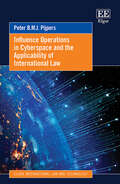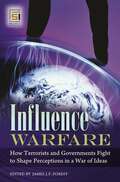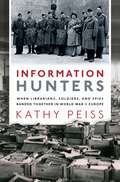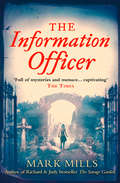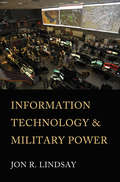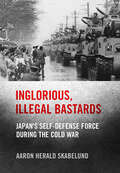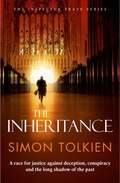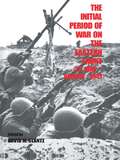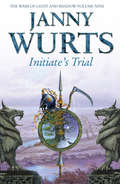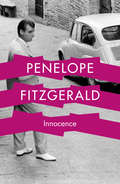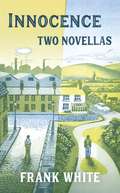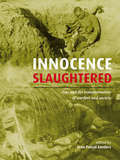- Table View
- List View
Influence Operations in Cyberspace and the Applicability of International Law (Elgar International Law and Technology series)
by Peter B.M.J. PijpersThis enlightening book examines the use of online influence operations by foreign actors, and the extent to which these violate international law. It looks at key recent examples such as the 2016 UK EU Referendum, the 2016 American Presidential Election, and the 2017 French Presidential Election.Applying existing international law to the new cyberspace domain fuels the discourse on how states interpret international law, which increases legal ambiguity. This book contributes to this discourse by analysing the core elements of interventions and sovereignty, including territorial integrity and political independence, and the extent to which these elements were violated in the three central case studies. It concludes by reflecting on the future of influence operations in cyberspace and providing instruments and tools to better define when and how international law has been violated.Providing insights into the use of coercion and manipulation in influence operations, this book will be crucial reading for students and scholars in information and media law, internet and technology law, and public international law. It will also be beneficial for cyberspace experts and policymakers in international law and governance.
Influence Warfare: How Terrorists and Governments Fight to Shape Perceptions in a War of Ideas (Praeger Security International)
by James J. ForestThis important work, edited by an expert on terrorism, focuses on the 21st-century struggle for strategic influence and ways in which states can neutralize the role of new media in spreading terrorist propaganda.In an era where anyone can have access to the Internet or other media forms that make widespread communication easy, terrorists and insurgents can spread their messages with complete freedom, creating challenges for national security. Influence Warfare: How Terrorists and Governments Fight to Shape Perceptions in a War of Ideas focuses on the core of the ongoing struggle for strategic influence and, particularly, how states can counter the role media and the Internet play in radicalizing new agents of terrorism. As the book makes clear, governments need to find ways to effectively confront non-state adversaries at all levels of the information domain and create an understanding of strategic communications within a broad range of technologies. The essays from the international group of authors who contributed to this work offer a deeper understanding of the ongoing struggle. Influence Warfare also provides a set of case studies that illustrate how the means and methods of strategic influence can impact a nation's security.
Influence Warfare: How Terrorists and Governments Fight to Shape Perceptions in a War of Ideas (Praeger Security International)
by James J. ForestThis important work, edited by an expert on terrorism, focuses on the 21st-century struggle for strategic influence and ways in which states can neutralize the role of new media in spreading terrorist propaganda.In an era where anyone can have access to the Internet or other media forms that make widespread communication easy, terrorists and insurgents can spread their messages with complete freedom, creating challenges for national security. Influence Warfare: How Terrorists and Governments Fight to Shape Perceptions in a War of Ideas focuses on the core of the ongoing struggle for strategic influence and, particularly, how states can counter the role media and the Internet play in radicalizing new agents of terrorism. As the book makes clear, governments need to find ways to effectively confront non-state adversaries at all levels of the information domain and create an understanding of strategic communications within a broad range of technologies. The essays from the international group of authors who contributed to this work offer a deeper understanding of the ongoing struggle. Influence Warfare also provides a set of case studies that illustrate how the means and methods of strategic influence can impact a nation's security.
The Informant: A Novel
by Andrew RosenheimAutumn 1941: most of the world is at war. America is hovering on the brink.Special Agent James Nessheim is stuck in Hollywood, working as an adviser to a studio making pro-FBI movies.And then one his key informants, Japanese-American Billy Osaka, asks to see him urgently. But before they can meet, Osaka vanishes. Nessheim’s search for Osaka takes him to a Mob-run gambling club, through the dense streets of LA’s Little Tokyo, from the seamy San Pedro docks to the hill-top ranch of a Communist sympathiser.As Nessheim begins to unravel Osaka’s deadly secrets, he uncovers a chilling conspiracy to push America into the war. But other people are looking for Osaka too, and are prepared to kill anyone who gets in their way. A lethal race is on.
Information at Sea: Shipboard Command and Control in the U.S. Navy, from Mobile Bay to Okinawa (Johns Hopkins Studies in the History of Technology)
by Timothy S. WoltersThe brain of a modern warship is its combat information center (CIC). Data about friendly and enemy forces pour into this nerve center, contributing to command decisions about firing, maneuvering, and coordinating. Timothy S. Wolters has written the first book to investigate the history of the CIC and the many other command and control systems adopted by the U.S. Navy from the Civil War to World War II. What institutional ethos spurred such innovation? Information at Sea tells the fascinating stories of the naval and civilian personnel who developed an array of technologies for managing information at sea, from signal flares and radio to encryption machines and radar.Wolters uses previously untapped archival sources to explore how one of America's most technologically oriented institutions addressed information management before the advent of the digital computer. He argues that the human-machine systems used to coordinate forces were as critical to naval successes in World War II as the ships and commanders more familiar to historians.
Information at Sea: Shipboard Command and Control in the U.S. Navy, from Mobile Bay to Okinawa (Johns Hopkins Studies in the History of Technology)
by Timothy S. WoltersThe brain of a modern warship is its combat information center (CIC). Data about friendly and enemy forces pour into this nerve center, contributing to command decisions about firing, maneuvering, and coordinating. Timothy S. Wolters has written the first book to investigate the history of the CIC and the many other command and control systems adopted by the U.S. Navy from the Civil War to World War II. What institutional ethos spurred such innovation? Information at Sea tells the fascinating stories of the naval and civilian personnel who developed an array of technologies for managing information at sea, from signal flares and radio to encryption machines and radar.Wolters uses previously untapped archival sources to explore how one of America's most technologically oriented institutions addressed information management before the advent of the digital computer. He argues that the human-machine systems used to coordinate forces were as critical to naval successes in World War II as the ships and commanders more familiar to historians.
Information Hunters: When Librarians, Soldiers, and Spies Banded Together in World War II Europe
by Kathy PeissWhile armies have seized enemy records and rare texts as booty throughout history, it was only during World War II that an unlikely band of librarians, archivists, and scholars traveled abroad to collect books and documents to aid the military cause. Galvanized by the events of war into acquiring and preserving the written word, as well as providing critical information for intelligence purposes, these American civilians set off on missions to gather foreign publications and information across Europe. They journeyed to neutral cities in search of enemy texts, followed a step behind advancing armies to capture records, and seized Nazi works from bookstores and schools. When the war ended, they found looted collections hidden in cellars and caves. Their mission was to document, exploit, preserve, and restitute these works, and even, in the case of Nazi literature, to destroy them. In this fascinating account, cultural historian Kathy Peiss reveals how book and document collecting became part of the new apparatus of intelligence and national security, military planning, and postwar reconstruction. Focusing on the ordinary Americans who carried out these missions, she shows how they made decisions on the ground to acquire sources that would be useful in the war zone as well as on the home front. These collecting missions also boosted the postwar ambitions of American research libraries, offering a chance for them to become great international repositories of scientific reports, literature, and historical sources. Not only did their wartime work have lasting implications for academic institutions, foreign-policy making, and national security, it also led to the development of today's essential information science tools. Illuminating the growing global power of the United States in the realms of intelligence and cultural heritage, Peiss tells the story of the men and women who went to Europe to collect and protect books and information and in doing so enriches the debates over the use of data in times of both war and peace.
Information Hunters: When Librarians, Soldiers, and Spies Banded Together in World War II Europe
by Kathy PeissWhile armies have seized enemy records and rare texts as booty throughout history, it was only during World War II that an unlikely band of librarians, archivists, and scholars traveled abroad to collect books and documents to aid the military cause. Galvanized by the events of war into acquiring and preserving the written word, as well as providing critical information for intelligence purposes, these American civilians set off on missions to gather foreign publications and information across Europe. They journeyed to neutral cities in search of enemy texts, followed a step behind advancing armies to capture records, and seized Nazi works from bookstores and schools. When the war ended, they found looted collections hidden in cellars and caves. Their mission was to document, exploit, preserve, and restitute these works, and even, in the case of Nazi literature, to destroy them. In this fascinating account, cultural historian Kathy Peiss reveals how book and document collecting became part of the new apparatus of intelligence and national security, military planning, and postwar reconstruction. Focusing on the ordinary Americans who carried out these missions, she shows how they made decisions on the ground to acquire sources that would be useful in the war zone as well as on the home front. These collecting missions also boosted the postwar ambitions of American research libraries, offering a chance for them to become great international repositories of scientific reports, literature, and historical sources. Not only did their wartime work have lasting implications for academic institutions, foreign-policy making, and national security, it also led to the development of today's essential information science tools. Illuminating the growing global power of the United States in the realms of intelligence and cultural heritage, Peiss tells the story of the men and women who went to Europe to collect and protect books and information and in doing so enriches the debates over the use of data in times of both war and peace.
The Information Officer: A Novel
by Mark MillsFrom the No. 1 bestseller and author of Richard & Judy pick The Savage Garden: an atmospheric world war two crime thriller for fans of Carlos Ruiz Zafon and Jed Rubenfeld
Information Technology and Military Power (Cornell Studies in Security Affairs)
by Jon R. LindsayMilitaries with state-of-the-art information technology sometimes bog down in confusing conflicts. To understand why, it is important to understand the micro-foundations of military power in the information age, and this is exactly what Jon R. Lindsay's Information Technology and Military Power gives us. As Lindsay shows, digital systems now mediate almost every effort to gather, store, display, analyze, and communicate information in military organizations. He highlights how personnel now struggle with their own information systems as much as with the enemy.Throughout this foray into networked technology in military operations, we see how information practice—the ways in which practitioners use technology in actual operations—shapes the effectiveness of military performance. The quality of information practice depends on the interaction between strategic problems and organizational solutions. Information Technology and Military Power explores information practice through a series of detailed historical cases and ethnographic studies of military organizations at war. Lindsay explains why the US military, despite all its technological advantages, has struggled for so long in unconventional conflicts against weaker adversaries. This same perspective suggests that the US retains important advantages against advanced competitors like China that are less prepared to cope with the complexity of information systems in wartime. Lindsay argues convincingly that a better understanding of how personnel actually use technology can inform the design of command and control, improve the net assessment of military power, and promote reforms to improve military performance. Warfighting problems and technical solutions keep on changing, but information practice is always stuck in between.
Information Warfare in the Age of Cyber Conflict (Routledge Studies in Conflict, Security and Technology)
by Christopher Whyte Brian M. Mazanec A. Trevor ThrallThis book examines the shape, sources and dangers of information warfare (IW) as it pertains to military, diplomatic and civilian stakeholders. Cyber warfare and information warfare are different beasts. Both concern information, but where the former does so exclusively in its digitized and operationalized form, the latter does so in a much broader sense: with IW, information itself is the weapon. The present work aims to help scholars, analysts and policymakers understand IW within the context of cyber conflict. Specifically, the chapters in the volume address the shape of influence campaigns waged across digital infrastructure and in the psychology of democratic populations in recent years by belligerent state actors, from the Russian Federation to the Islamic Republic of Iran. In marshalling evidence on the shape and evolution of IW as a broad-scoped phenomenon aimed at societies writ large, the authors in this book present timely empirical investigations into the global landscape of influence operations, legal and strategic analyses of their role in international politics, and insightful examinations of the potential for democratic process to overcome pervasive foreign manipulation. This book will be of much interest to students of cybersecurity, national security, strategic studies, defence studies and International Relations in general.
Information Warfare in the Age of Cyber Conflict (Routledge Studies in Conflict, Security and Technology)
by Christopher Whyte Brian M. Mazanec Trevor ThrallThis book examines the shape, sources and dangers of information warfare (IW) as it pertains to military, diplomatic and civilian stakeholders. Cyber warfare and information warfare are different beasts. Both concern information, but where the former does so exclusively in its digitized and operationalized form, the latter does so in a much broader sense: with IW, information itself is the weapon. The present work aims to help scholars, analysts and policymakers understand IW within the context of cyber conflict. Specifically, the chapters in the volume address the shape of influence campaigns waged across digital infrastructure and in the psychology of democratic populations in recent years by belligerent state actors, from the Russian Federation to the Islamic Republic of Iran. In marshalling evidence on the shape and evolution of IW as a broad-scoped phenomenon aimed at societies writ large, the authors in this book present timely empirical investigations into the global landscape of influence operations, legal and strategic analyses of their role in international politics, and insightful examinations of the potential for democratic process to overcome pervasive foreign manipulation. This book will be of much interest to students of cybersecurity, national security, strategic studies, defence studies and International Relations in general.
Inge's War: A Story of Family, Secrets and Survival under Hitler
by Svenja O’Donnell'A lyrical, engrossing and essential read' - Sathnam Sanghera 'A superbly nuanced reclamation of history and family secrets' - Brian Van Reet, author of SpoilsWhat does it mean to be on the wrong side of history?Svenja O'Donnell’s beautiful, aloof grandmother Inge never spoke about the past. All her family knew was that she had grown up in a city that no longer exists on any map: Königsberg in East Prussia, a footnote in history, a place that almost no one has heard of today. But when Svenja impulsively visits this windswept Baltic city, something unlocks in Inge and, finally, she begins to tell her story.It begins in the secret jazz bars of Hitler’s Berlin. It is a story of passionate first love, betrayal, terror, flight, starvation and violence. As Svenja teases out the threads of her grandmother’s life, retracing her steps all over Europe, she realises that there is suffering here on a scale that she had never dreamt of. And finally, she uncovers a desperately tragic secret that her grandmother has been keeping for sixty years.Inge's War listens to the voices that are often missing from our historical narrative – those of women caught up on the wrong side of history. It is a book about memory and heritage that interrogates the legacy passed down by those who survive. It also poses the questions: who do we allow to tell their story? What do we mean by family? And what will we do in order to survive?
Inglorious, Illegal Bastards: Japan's Self-Defense Force during the Cold War (Studies of the Weatherhead East Asian Institute, Columbia University)
by Aaron SkabelundIn Inglorious, Illegal Bastards, Aaron Herald Skabelund examines how the Self-Defense Force (SDF)—the post–World War II Japanese military—and specifically the Ground Self-Defense Force (GSDF), struggled for legitimacy in a society at best indifferent to them and often hostile to their very existence.From the early iterations of the GSDF as the Police Reserve Force and the National Safety Force, through its establishment as the largest and most visible branch of the armed forces, the GSDF deployed an array of public outreach and public service initiatives, including off-base and on-base events, civil engineering projects, and natural disaster relief operations. Internally, the GSDF focused on indoctrination of its personnel to fashion a reconfigured patriotism and esprit de corps. These efforts to gain legitimacy achieved some success and influenced the public over time, but they did not just change society. They also transformed the force itself, as it assumed new priorities and traditions and contributed to the making of a Cold War defense identity, which came to be shared by wider society in Japan. As Inglorious, Illegal Bastards demonstrates, this identity endures today, several decades after the end of the Cold War.
The Inheritance: Orders From Berlin, The Inheritance, The King Of Diamonds (Inspector Trave Ser. #1)
by Simon TolkienWhen an eminent art historian is found dead in his study, all the evidence points to his estranged son, Stephen. With his fingerprints on the murder weapon, Stephen’s guilt seems undeniable.
The Inheritance of Solomon Farthing
by Mary Paulson-EllisFrom The Times bestselling author of The Other Mrs Walker – Waterstones Scottish Book of the Year 2017 – comes Mary Paulson-Ellis's second stunning historical mystery, The Inheritance of Solomon Farthing. Solomon knew that he had one advantage. A pawn ticket belonging to a dead man tucked into his top pocket – the only clue to the truth . . . An old soldier dies alone in his Edinburgh nursing home. No known relatives, and no Will to enact. Just a pawn ticket found amongst his belongings, and fifty thousand pounds in used notes sewn into the lining of his burial suit . . . Heir Hunter, Solomon Farthing – down on his luck, until, perhaps, now – is tipped off on this unexplained fortune. Armed with only the deceased’s name and the crumpled pawn ticket, he must find the dead man’s closest living relative if he is to get a cut of this much-needed cash. But in trawling through the deceased’s family tree, Solomon uncovers a mystery that goes back to 1918 and a group of eleven soldiers abandoned in a farmhouse billet in France in the weeks leading up to the armistice. Set between contemporary Edinburgh and the final brutal days of the First World War as the soldiers await their orders, The Inheritance of Solomon Farthing shows us how the debts of the present can never be settled unless those of the past have been paid first . . .
Inheriting the Bomb: The Collapse of the USSR and the Nuclear Disarmament of Ukraine (Johns Hopkins Nuclear History and Contemporary Affairs)
by Mariana BudjerynThe collapse of the Soviet Union unleashed the specter of the largest wave of nuclear proliferation in history. Why did Ukraine ultimately choose the path of nuclear disarmament?The collapse of the Soviet Union in 1991 left its nearly 30,000 nuclear weapons spread over the territories of four newly sovereign states: Belarus, Kazakhstan, the Russian Federation, and Ukraine. This collapse cast a shadow of profound ambiguity over the fate of the world's largest arsenal of the deadliest weapons ever created. In Inheriting the Bomb, Mariana Budjeryn reexamines the history of nuclear predicament caused by the Soviet collapse and the subsequent nuclear disarmament of the non-Russian Soviet successor states.Although Belarus and Kazakhstan renounced their claim to Soviet nuclear weapons, Ukraine proved to be a difficult case: with its demand for recognition as a lawful successor state of the USSR, a nuclear superpower, the country became a major proliferation concern. And yet by 1994, Ukraine had acceded to the Treaty on the Non-proliferation of Nuclear Weapons (NPT) as a non-nuclear-weapon state and proceeded to transfer its nuclear warheads to Russia, which emerged as the sole nuclear successor of the USSR. How was this international proliferation crisis averted? Drawing on extensive archival research in the former Soviet Union and the United States, Budjeryn uncovers a fuller and more nuanced narrative of post-Soviet denuclearization. She reconstructs Ukraine's path to nuclear disarmament to understand how its leaders made sense of the nuclear armaments their country inherited. Among the various factors that contributed to Ukraine's nuclear renunciation, including diplomatic pressure from the United States and Russia and domestic economic woes, the NPT stands out as a salient force that provided an international framework for managing the Soviet nuclear collapse.
Inheriting the Bomb: The Collapse of the USSR and the Nuclear Disarmament of Ukraine (Johns Hopkins Nuclear History and Contemporary Affairs)
by Mariana BudjerynThe collapse of the Soviet Union unleashed the specter of the largest wave of nuclear proliferation in history. Why did Ukraine ultimately choose the path of nuclear disarmament?The collapse of the Soviet Union in 1991 left its nearly 30,000 nuclear weapons spread over the territories of four newly sovereign states: Belarus, Kazakhstan, the Russian Federation, and Ukraine. This collapse cast a shadow of profound ambiguity over the fate of the world's largest arsenal of the deadliest weapons ever created. In Inheriting the Bomb, Mariana Budjeryn reexamines the history of nuclear predicament caused by the Soviet collapse and the subsequent nuclear disarmament of the non-Russian Soviet successor states.Although Belarus and Kazakhstan renounced their claim to Soviet nuclear weapons, Ukraine proved to be a difficult case: with its demand for recognition as a lawful successor state of the USSR, a nuclear superpower, the country became a major proliferation concern. And yet by 1994, Ukraine had acceded to the Treaty on the Non-proliferation of Nuclear Weapons (NPT) as a non-nuclear-weapon state and proceeded to transfer its nuclear warheads to Russia, which emerged as the sole nuclear successor of the USSR. How was this international proliferation crisis averted? Drawing on extensive archival research in the former Soviet Union and the United States, Budjeryn uncovers a fuller and more nuanced narrative of post-Soviet denuclearization. She reconstructs Ukraine's path to nuclear disarmament to understand how its leaders made sense of the nuclear armaments their country inherited. Among the various factors that contributed to Ukraine's nuclear renunciation, including diplomatic pressure from the United States and Russia and domestic economic woes, the NPT stands out as a salient force that provided an international framework for managing the Soviet nuclear collapse.
The Initial Period of War on the Eastern Front, 22 June - August 1941: Proceedings Fo the Fourth Art of War Symposium, Garmisch, October, 1987 (Soviet (Russian) Military Experience)
by David M. GlantzBeginning with Operation Barbarossa, the German invasion of the Soviet Union in June 1941, this volume draws upon eye-witness German accounts supplemented with German archival and detailed Soviet materials. Formerly classified Soviet archival materials has been incorporated.
The Initial Period of War on the Eastern Front, 22 June - August 1941: Proceedings Fo the Fourth Art of War Symposium, Garmisch, October, 1987 (Soviet (Russian) Military Experience)
by David M. GlantzBeginning with Operation Barbarossa, the German invasion of the Soviet Union in June 1941, this volume draws upon eye-witness German accounts supplemented with German archival and detailed Soviet materials. Formerly classified Soviet archival materials has been incorporated.
Initiate’s Trial: First book of Sword of the Canon (The Wars of Light and Shadow #9)
by Janny WurtsThe long-awaited beginning of the fourth story arc - Sword of the Canon - in the epic fantasy series, the Wars of Light and Shadow.
Innocence
by Penelope FitzgeraldStunning modern new cover reissue of one of Penelope Fitzgerald’s best-loved novels
Innocence: two novellas
by Frank WhiteIn 2017 Hodder published Frank White's There Was A Time, surely the last novel about the Second World War to be written by someone who actually served in it. Now at the age of 93, Frank has written a poignant, nostalgic novella of coming of age in a Yorkshire village in the sixties and it is paired with another short novel set in Manchester at the outbreak of war and first published by Hodder in 1964. Innocence and A Morse Code Set are beautifully complementary in theme and show Frank White to be an author of extraordinary insight and tenderness.
Innocence Slaughtered: Gas and the Transformation of Warfare and Society
by Jean Pascal ZandersThis collaborative work investigates the unfolding catastrophe that the unleashing of chlorine against the Allied positions meant for individual soldiers and civilians. It describes the hesitation on the German side about the effectiveness, and hence impact on combat operations of the weapon whilst reflecting on the lack of Allied response to the many intelligence pointers that something significant was afoot.It goes on to describe the massive transformation that societies were undergoing as a consequence of industrialisation, science and technology, and the impact these trends were to have on the emergence of what we know today as 'total war'. Chemical warfare pitted the brightest minds from the various belligerents against each other and in some ways this competition revealed early thinking about intellectual superiority that was to define the decades after the Armistice. The ability to survive in a chemically contaminated environment was proof of a higher level of achievement. In simple terms, chemical defence equalled survival of the fittest.
Innocents Lost: When Child Soldiers Go To War
by Jimmie BriggsIda, a member of Sri Lanka's Female Tamil Tigers, fought with one of the longest-surviving and successful guerilla movements in the world. She is sixteen. Francois, a fourteen-year-old Rwandan child of mixed ethnicity, was forced by Hutu militiamen to hack to death his sister's Tutsi children.More than 250,000 children have fought in three dozen conflicts around the world, but growing exploitation of children in war is staggering and little known. From the “little bees” of Colombia to the “baby brigades” of Sri Lanka, the subject of child soldiers is changing the face of terrorism. For the last seven years, Jimmie Briggs has been talking to, writing about, and researching the plight of these young combatants. The horrific stories of these children, dramatically told in their own voices, reveal the devastating consequences of this global tragedy.Cogent, passionate, impeccably researched, and compellingly told, Innocents Lost is the fullest, most personal and powerful examination yet of the lives of child soldiers.
